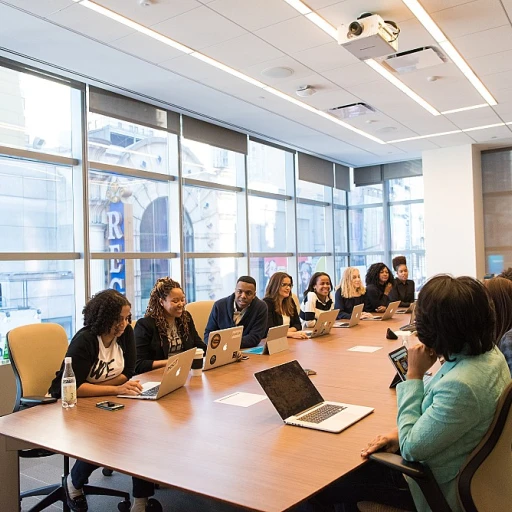Understanding the Value of Mixed Experience Levels
The Power of Diverse Experience Levels in Teams
In the ever-evolving landscape of modern work, the combination of experienced and inexperienced employees within a team can be a significant asset. The dynamic that emerges from this blend can enhance creativity, innovation, and problem-solving capabilities. Experienced workers bring a wealth of knowledge and a deep understanding of industry nuances, while inexperienced employees often offer fresh perspectives and a willingness to challenge the status quo.
Research from various studies, including those conducted at state universities, supports the hypothesis that mixed experience levels can lead to superior team performance. Experienced employees contribute their years of experience, providing mentorship and guidance, while inexperienced workers inject new energy and ideas. This combination can foster a company culture that values both tradition and innovation.
Benefits of Hiring a Mixed Experience Team
- Enhanced Creativity: Diverse perspectives can lead to more innovative solutions.
- Improved Problem-Solving: A mix of skills allows for a more comprehensive approach to challenges.
- Balanced Workload: Experienced employees can take on complex tasks, while inexperienced workers handle routine activities, optimizing productivity.
- Long-Term Growth: Inexperienced employees benefit from on-the-job training, gradually becoming experienced themselves, which contributes to the team’s long-term success.
However, integrating employees with varying levels of experience is not without its challenges. The role of leadership is crucial in managing these diverse teams, ensuring that both experienced and inexperienced participants feel valued and motivated. As we explore further, the strategies for effective integration and measuring success will shed light on how to maximize the potential of such teams. For more insights into building a successful team, visit this resource.
Challenges in Grouping Diverse Experience Levels
Bridging the Gaps: Navigating the Hurdles
The process of grouping individuals with diverse experience levels in the workplace presents a complex set of challenges. From integrating inexperienced employees with seasoned professionals to aligning varied skill sets, companies face a multitude of hurdles. Let's explore some of these challenges and how they manifest in the workforce. Firstly, it's important to recognize the different perspectives and approaches that experienced and inexperienced employees bring to the table. Inexperienced workers may have fresh views but can lack the depth of understanding that experienced counterparts possess. On the other hand, experienced employees often rely on years of experience, which might inhibit the adoption of innovative techniques. The quality of communication is another potential stumbling block. Experienced employees might unconsciously use technical jargon or assume a knowledge base that inexperienced team members have not yet developed. This scenario can lead to misunderstandings, reducing overall team cohesion and cooperation. Moreover, companies might face resistance during the hiring process when attempting to integrate a mixed-experience team. Hiring experienced professionals often demands higher salaries, while hiring inexperienced candidates typically requires more robust training programs. Both require spending time and resources that must align with long-term company goals. Cultural differences can also pose a challenge when integrating mixed-experience groups. Seasoned employees may be accustomed to a particular company culture or set working practices, while inexperienced individuals might feel more adaptable to change. To navigate these challenges effectively, companies should commit to strategic planning and a supportive work environment. A well-designed training session can equip less experienced employees with necessary skills while considering the input of veteran staff members. Companies can thus ensure that all group participants benefit collectively. In conclusion, bridging the gap between varying experience levels is no easy feat. Organizations must address these challenges transparently and develop hypotheses to enhance teamwork and communication. By doing so, they can optimize the team dynamics and improve the overall employee experience. For those interested in further exploring team integration strategies, a comprehensive resource is available here.Strategies for Effective Integration
Strategies for Seamless Team Integration
Formulating effective strategies for integrating a mix of experienced and inexperienced employees can significantly improve team performance and contribute to a thriving company culture. To achieve this, several approaches can be implemented:- Mentoring and Peer Support: Pairing experienced workers with inexperienced people can accelerate the exchange of skills and insights. By promoting mentorship, new hires benefit from the wisdom and years of experience of seasoned employees, fostering faster adaptation and competence in their roles.
- Targeted Training Sessions: Tailored training focusing on specific skills gaps ensures both inexperienced and experienced employees are equipped to fulfill their roles effectively. A well-thought-out training session design is paramount, taking into consideration individual needs and the overall group dynamic, ultimately enhancing work quality across the team.
- Encouraging Open Dialogue: Regular team meetings and feedback loops can facilitate an open platform where both inexperienced employees and experienced ones feel heard. These interactions allow participants to exchange great questions and hypotheses about improving workflows and solving problems collaboratively.
- Data-Driven Insights: Utilizing data from team performance and employee feedback can provide a clear assessment of group dynamics. Analyzing this data helps in adjusting strategies over time, ensuring that both new and seasoned employees continue to thrive in the changing landscape of the company.
- Celebrating Small Wins: Recognizing and appreciating the efforts of all team members, irrespective of their experience level, promotes unity. Offering appreciation cards and celebrating employee contributions can create a positive reinforcement loop, enhancing motivation and team cohesion.
Role of Leadership in Managing Diverse Teams
Leadership's Influence on Cohesive Team Dynamics
Effective leadership plays a pivotal role in fostering a collaborative and productive environment within teams of mixed experience levels. Leaders are tasked with the challenge of balancing the diverse abilities, skills, and perspectives that both inexperienced and experienced employees bring to the table. The ability to manage this diversity is a testament to strong leadership skills, which can significantly impact the outcomes of such teams.
Key Leadership Responsibilities Include:
- Communication Facilitation: Ensuring open lines of communication among all team members is vital. Leaders must encourage inexperienced people to voice their ideas while providing experienced workers with opportunities to share their knowledge.
- Building Inclusive Culture: Integrating a blend of experience levels calls for a company culture that respects and values each member's contributions. Establishing trust and inclusion helps in maximizing the strengths of both experienced and inexperienced employees.
- Providing Resources for Training: Experienced employees require different kinds of challenges compared to their less experienced counterparts. Leaders should organize training sessions that cater to varying experience levels, helping newer members climb the learning curve efficiently while allowing seasoned employees to continue developing their skills.
- Monitoring and Evaluation: Regular appraisal of the team’s progress and addressing challenges swiftly is crucial. Leadership should study data and monitor team interactions to measure quality and productivity, identifying areas that need improvement and ensuring that hypotheses about team dynamics are continually tested and adjusted.
For leaders, continuously questioning and refining the strategies employed to manage a mixed team can present great questions and learning opportunities. The role of leadership is not static; it evolves with the dynamics of the team, adapting as the team grows and its needs change over time. By fostering a harmonious and synergistic atmosphere, leadership can elevate the contributions of both inexperienced workers and experienced employees alike, paving the way for team success in the long term.
Measuring Success in Mixed Experience Teams
Evaluating the Success of Blended Experience Teams
Measuring the impact of mixing experienced and inexperienced employees requires careful analysis and a well-structured study design. The benefits of such integration may not be immediately apparent, but over time, the right metrics can reveal the strengths of a diverse team.- Employee Engagement Levels: An engaged team is often a productive one. Monitoring engagement through frequent surveys can provide data on how both experienced employees and their inexperienced counterparts are adjusting to the team dynamics.
- Improvement in Skills: Regular training sessions focused on enhancing the skills of inexperienced employees can highlight improvement areas. Tracking progress over several months will offer insights into how quickly employees adapt and learn from experienced employees.
- Productivity Metrics: Assessing output quality and efficiency can be an indicator of a successfully blended team. By comparing changes before and after hiring strategies are implemented, companies can ascertain their hypothesis regarding team performance.
- Feedback Mechanisms: To truly understand a team's functioning, collecting qualitative feedback from all group participants can shed light on the nuances that data might not capture. Comments on company culture often play a significant role in this analysis.













